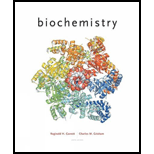
Concept explainers
Answers to all problems are at the end of this book. Detailed solutions are available in the Student Solutions Manual, Study Guide, and Problems Book.
Determining the Branch Points and Reducing Ends of Amylopectin A 0.2-g sample of amylopectin was analyzed to determine the fraction of the total glucose residues, that are branch points in the structure. The sample was exhaustively methylated and then digested, yielding 50-μmol of 2,3-dimethylgluetose and 0.4 μmol of 1,2,3,6- letramethylglucose.
- What fraction of the total residues are branch points?
- I low many reducing ends does this sample of amylopectin have?
(a)
Interpretation:
The fraction of the total residues that are branch points in the structure of amylopectin is to be calculated.
Concept Introduction:
The simplest hydrolyzed form that is obtained from the carbohydrates is known as monosaccharide. Polysaccharides are those types of sugars which contain more than ten units of monosaccharides.
Amylopectin is a polysaccharide and is one of the two forms of starch. It is composed of long chain of glucose attached by the
Answer to Problem 8P
The fraction of the total residues that are branch points in the structure of amylopectin is
Explanation of Solution
The given mass of amylopectin sample is
The given amount of
The conversion of
Thus, the moles of
The given amount of
The molecular weight of glucose is
The molecular weight of water is
If glucose unit losses a water molecule while forming a glycosidic linkage in amylopectin, then, the molecular weight of glucose in amylopectin is
The moles of a substance is calculated by the equation as,
Substitute the value of mass and molar mass of the sample in the above equation.
The moles of
Substitute the values of moles of
Thus, the fraction of the total residues that are branch points in the structure of amylopectin is
(b)
Interpretation:
The total number of reducing ends possessed by the sample of amylopectin is to be calculated.
Concept Introduction:
The simplest hydrolyzed form that is obtained from the carbohydrates is known as monosaccharide. Polysaccharides are those types of sugars which contain more than ten units of monosaccharides.
Amylopectin is a polysaccharide and is one of the two forms of starch. It is composed of long chain of glucose attached by the
Answer to Problem 8P
The total number of reducing ends possessed by the sample of amylopectin is
Explanation of Solution
The given amount of
The moles of the reducing ends is calculated by the moles of
If one mole of compounds possesses
Thus, the total number of reducing ends possessed by the sample of amylopectin is
Want to see more full solutions like this?
Chapter 7 Solutions
Biochemistry
- Calculate pH of a solution prepared by dissolving 1.60g of sodium acetate, in 88.5 mL of 0.10 M acetic acid. Assume the volume change upon dissolving the sodium acetate is negligible. Ka is 1.75 x 10^-5arrow_forwardShow a mechanism that leads to the opening of the ring below under acid-catalyzed conditions. Give the correct Fischer projection for this sugar.arrow_forwardWhat is the stereochemical relationship between B & C?arrow_forward
- Don't use ai or any chat gpt will dislike okk just use accurate information okkk okkk just solve full accurate. don't use guidelines okk just did it accurate 100% sure experts solve it correct complete solutions okkk follow all instructions requirements okkkarrow_forwardhow would you make this plot in excel?arrow_forwardwhat is the productarrow_forward
- Balance the following equation and list of coefficients in order from left to right. SF4+H2O+—-> H2SO3+HFarrow_forwardProblem 15 of 15 Submit Using the following reaction data points, construct Lineweaver-Burk plots for an enzyme with and without an inhibitor by dragging the points to their relevant coordinates on the graph and drawing a line of best fit. Using the information from this plot, determine the type of inhibitor present. 1 mM-1 1 s mM -1 [S]' V' with 10 μg per 20 54 10 36 20 5 27 2.5 23 1.25 20 Answer: |||arrow_forward12:33 CO Problem 4 of 15 4G 54% Done On the following Lineweaver-Burk -1 plot, identify the by dragging the Km point to the appropriate value. 1/V 40 35- 30- 25 20 15 10- T Км -15 10 -5 0 5 ||| 10 15 №20 25 25 30 1/[S] Г powered by desmosarrow_forward
 BiochemistryBiochemistryISBN:9781305577206Author:Reginald H. Garrett, Charles M. GrishamPublisher:Cengage Learning
BiochemistryBiochemistryISBN:9781305577206Author:Reginald H. Garrett, Charles M. GrishamPublisher:Cengage Learning
